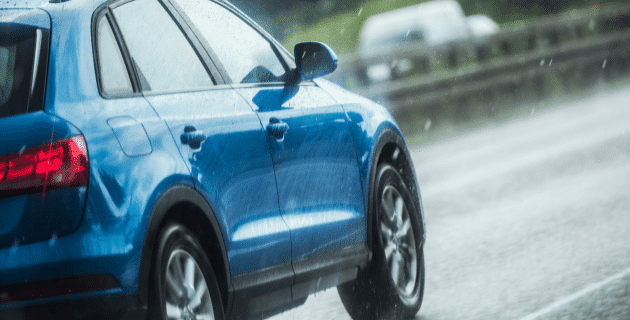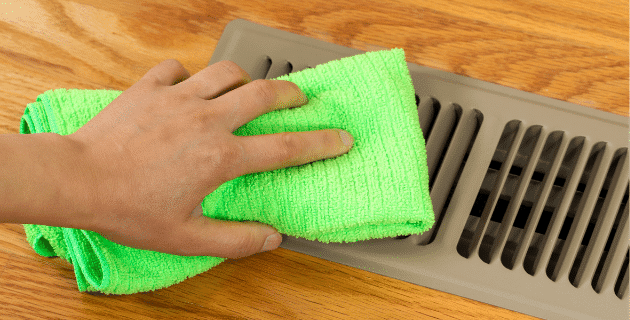
by California Casualty | Pets |
Hiding under the bed…shaking uncontrollably…pacing, panting, trembling …when your fur baby is frantic during a thunderstorm, it can be stressful for the both of you….
What makes your pet extra anxious during a storm and how can you help them cope? Let’s find out.
What makes my pet anxious?
Our pets’ hearing is far more sensitive than ours. That means our fur babies can hear a storm coming long before we do, and when it arrives, thunder is much louder to them than it is to us. When they hear loud noises, they react as if there is danger. When unsure of the location of the noise, a pet’s natural instinct is to seek a safe place.
Loud noises aren’t the only scary thing about storms. Storms can produce static electricity, which can run through a pet’s fur, creating uncomfortable feelings and even painful shocks if they come in contact with metal.
Some breeds are more likely to have storm anxiety. These include dog breeds like Australian Shepherds with double coats, and cats with long fur. In addition, dogs and cats who are naturally fearful, have separation anxiety, or hesitation around people are also more likely to be anxious about storms.
What are the signs of anxiety?
Pets show anxiety in many ways. Here are just a few of the signs you may notice:
-
- Drooling, panting, trembling, and ears back
- Hiding or trying to fit into tight spaces
- Moving close to a favorite person
- Whining, barking, pacing
- Scratching and acting out destructively
How can I help my pet?
Don’t worry, there are ways that you can calm your anxious pet the next time the thunder booms. Try to intervene early before the storm is in full swing. Reassure your fur baby in a low calm voice. High-pitched voices can cause our fur babies to panic. Plan to stay home with him or her, or ask someone else to do so. (An anxious pet left alone can cause some damage.)
Here’s what else you can do.
1. Set up a calming environment.
Pets sometimes seek shelter under your bed or in a closet. They feel safer in an enclosed space.
-
- Pay attention to where your dog or cat likes to go during a thunderstorm, and start with that space to set up a calming environment.
- If your dog is crate trained, you can set up its crate in the most soundproof room of the home.
- Try an interior room without windows so that your pet won’t see the flashes of lightning.
- Many pets stay away from carpets and fabric, due to the effect of static. Consider a space such as a bathroom. Your pet may even prefer to sleep in the tub.
- Leave the light and tv on so that the flashes of lightning and cracks of thunder are less noticeable. Close the blinds and drapes.
2. Distract and/or desensitize your pet.
If your pet isn’t too frantic, you may be able to distract him or her. Try any of the strategies below, and keep in mind that in between storms, you can work to desensitize pets to help them manage their future stress.
-
- Choose interactive toys. Play a game of indoor fetch or tug-of-war.
- Consider a high-value chew or a treat. Just make sure you’re not treating your pet every time he or she seems fearful or you are rewarding this behavior.
- Licking is a way for dogs and cats to calm themselves. Try giving your fur baby a licking pad with their favorite wet food or soft treat.
- Try giving your pet a calming massage.
- Desensitize your dog for future storms. Play a thunderstorm soundtrack on a low volume while giving your pet high-value treats and positive interactions. Over several weeks, gradually increase the volume. This can help lessen or even eliminate thunderstorm anxiety.
3. Try natural therapies.
There are several natural ways that you can help reduce the stress of a thunderstorm for your pet.
-
- If your pet’s anxiety is tied to static electricity in his or her fur, try a dryer sheet. Rub the sheet gently along your pet’s fur to cut down on the static. Choose an unscented brand, and do not let your fur baby chew or play with it.
- Try a thunder jacket. This type of pet clothing holds your pet snugly and helps them feel safe and secure. You can make your own with a t-shirt or sweatshirt. Put it over your dog’s head with the front/pattern across his/her back. Put the dog’s front legs through the armholes. Tie up any looseness toward the dog’s rump.
- Set up a white noise sound machine or play calming music.
- Add a soothing scent, such as a few drops of lavender oil on a cotton ball. Or try a dog or cat pheromone spray or collar that can help them to relax.
4. If all else fails, try prescription therapy.
In some cases, medication is needed to help keep your fur baby calm. You can try calming treats available at your local pet store or talk to your vet about whether your dog or cat is a candidate for an anxiety prescription.
This article is furnished by California Casualty, providing auto and home insurance to educators, law enforcement officers, firefighters, and nurses. Get a quote at 1.866.704.8614 or www.calcas.com.

by California Casualty | Auto Insurance Info |
From hail to high winds, flooding, and more, spring storms can do some real damage — and not just to your home and property. These intense storms can also take their toll on your car.
Here are some ways you can protect your vehicle from spring storms.
Take cover – and cover-up — during hailstorms.
Hailstorms do billions of dollars of damage each year, according to the Insurance Information Institute. If you live in one of the states that typically receives a lot of hail, your car could be at even greater risk. But even if you don’t, it only takes one bad hailstorm to dent your vehicle or crack your windshield.
-
- If you have a garage or barn, park your car inside. Being in an enclosed structure will help protect your car from hailstones and flying debris.
- It may be a bit inconvenient but you can find covered parking in malls or parking garages. Park above the ground floor to minimize contact with water in case there is flooding.
- If you cannot park inside, move your car away from trees. Park near the side of a building or your house for some protection.
- Cover your vehicle with a car cover. You can buy one or make your own with blankets. Secure the blankets with duct tape; while it may leave a sticky residue, it will not damage your paint.
- If you’re driving when a hailstorm hits, pull over. Hailstones fall at a pretty good speed. When you add your car’s forward motion, that actually increases the impact.
Stay far from trees and other cars in high winds.
High or straight-line winds can leave destruction in their wake, from downed trees to flying debris. Check with your local weather service on wind speeds and know what wind can do. Winds traveling at 50 mph can move patio furniture. At 60 mph, they can pick up a car and shatter windows.
-
- Park away from trees, which could potentially fall or drop heavy branches on your vehicle. Stay away from power lines, too.
- Park inside if space is available. Reinforced garage doors are helpful if you’re in a place with frequent high winds.
- If time permits, trim your tree branches in advance of the storm. Also, remove any items that could potentially impact your car.
- Remove valuables from your car that could be blown away if winds hit high speeds and shatter your windows. Don’t tape your windows; it’s a myth that tape will help contain the glass and prevent tiny shards from flying around.
- If you’re driving in strong winds, consider pulling over. If you continue driving, keep plenty of space between you and the cars around you.
Stay high and dry when it rains and floods.
Rain and flooding can cause serious problems with your car. Water can damage your engine, electrical components, and interior. Its effects may not even show up immediately. You may have trouble starting your car, or notice premature rusting.
-
- Make sure your windows are rolled up, and your sunroof is closed before a rainstorm. If water gets inside your car, it can cause mold to grow.
- Store important documents for your car in a water-tight bag.
- Park on high ground if possible, or in a garage.
- You can purchase a flood cover that may help to protect your car.
- Avoid driving through pools of water. The water could reach your car’s undercarriage.
- Stay off the roads if you can. Floodwaters can rise quickly and you want to avoid contact with your car.
- If your vehicle stalls in a flooded area, do not remain with your car. Exit your vehicle and get to high ground. It takes just 12 inches of rushing water to carry away a small car and 2 feet of rushing water can carry away most vehicles, according to AAA.
Know what to expect and plan ahead.
Your local town or your state will likely issue severe weather alerts. Getting a heads up on impending storms will help you make the proper preparations ahead of storms this spring.
-
- Download a weather app on your phone for advance notice.
- Research places in case you need to take shelter, including where to park your car.
- Check your tires and make sure they are fully inflated.
- Check your windshield wipers and replace blades that leave streaks.
- Make sure that you have a full tank of gas in case you need to evacuate.
Make sure you have the right insurance coverage to protect your vehicle.
Despite your best efforts to protect your vehicle, sometimes damage happens. But if you have the right insurance coverage, you’ll likely be able to repair or replace your vehicle without large out-of-pocket costs.
-
- Comprehensive coverage is for natural disasters, fires, vandalism, theft, and animals that damage your vehicle. Think of it as “bad luck coverage.” Comprehensive coverage is not usually required unless you’re leasing a vehicle or paying a car loan. However, it’s valuable to protect your car from spring storm damage.
- If your car needs to stay in the shop, an insurance policy with rental car coverage will be most helpful.
- If spring storms damage your car to the extent that it is totaled, your insurance policy will likely pay you for the actual cash value of your car.
- Talk to your insurance agent to see what is covered under your auto policy before spring storms hit!
This article is furnished by California Casualty, providing auto and home insurance to educators, law enforcement officers, firefighters, and nurses. Get a quote at 1.866.704.8614 or www.calcas.com.

by California Casualty | Homeowners Insurance Info |
There’s a reason spring cleaning is so popular-the birds are chirping, the sun is shining, and there is a sense of newness in the air! There’s no better time to open up those windows and scrub away all signs of winter. However, spring cleaning isn’t just for dusting and decluttering. It’s also a great chance to assess and address safety issues, especially fire hazards.
Every 89 seconds, a fire department responds to a home fire in the U.S. And according to the National Fire Protection Association, in 2020, home fires were responsible for 3,500 deaths, 15,200 injuries, and $21.9 billion in property damage.
When you clean with fire safety in mind, you help protect your home and family from these often-unforeseen fire safety dangers. To help you stay safe this season, we’ve compiled the top safety cleaning tips from fire departments around the country.
Tip #1: Clear your stovetop of fire hazards.
Stovetops account for the majority of kitchen fires. Making sure that there are no flammable hazards nearby will help prevent the flames from catching and spreading a fire.
-
- Keep your stovetop clean between cooking meals.
- Put space between your stove and anything flammable: oven mitts, wooden utensils, towels, wooden stove covers, and kitchen curtains.
- Keep your kitchen counter free of grease or clutter.
- Always stay near the food you are cooking.
- Turn pot handles inward so you can’t accidentally bump them.
Tip #2: Clean the lint trap in your dryer.
Dryers are a common cause of home fires, and too often, the lint traps are the culprit. Making sure your lint trap is not too full will help.
-
- Clean lint filters before or after each load.
- Remove lint from around the dryer rim.
- Make sure the air exhaust vent pipe is free and clear, and that the outdoor vent flap opens when the dryer is on.
- Move flammable items like cardboard and cleaning supplies away from the dryer, especially when it is on.
Tip #3: Check extension cords, outlets, and wiring.
Damaged cords, overtaxed outlets, and old wiring can cause electrical fires. Check these items to make sure that your electrical setup is not putting your safety at risk.
-
- Check for frayed or damaged extension cords. If you find any, throw them out and replace them.
- Make sure your extension cords are rated for the appliances and items that they are powering.
- Do not put electric cords under carpets or across doorways.
- Check to make sure that your outlets aren’t overloaded.
- If an electric appliance smokes, smells funny, or is drawing heat when plugged in, unplug it.
- If you’re familiar with your home’s electrical system and you can take a look, check for scorch marks or frayed wires. Call an electrician to update or rewire the system.
Tip #4: Check for potential fire hazards.
As you do your spring cleaning, check your home for possible fire hazards. Then, take the steps to minimize their risk.
-
- Keep space heaters at least 3 feet from anything that can burn. Turn them off before leaving the room and before going to sleep.
- Practice safety with candle flames. Store matches where children cannot get them. Alternatively use child-resistant lighters.
- If you have a chimney, get it professionally cleaned and inspected. Chimneys can have a build-up accumulation of creosote, a flammable substance that lines the flue.
- Keep cleaning fluids away from heat sources. Many are combustible. These chemicals could even heat up to dangerous levels outside in the sun. (Consider non-toxic cleaners that are safer when heated, such as vinegar mixed with water.)
Tip #5: Remove potential hazards from the garage.
The garage is where we often store our extra stuff. That includes items that could fuel a fire. As part of your cleaning routine, declutter the garage.
-
- Remove stored newspapers, wrapping paper, blankets, and other flammable items that you may be storing in the garage.
- Dispose of oil or greasy rags. Never leave them in a pile. If you must keep them, store them in a labeled metal container.
- Move propane or gasoline outside your home to a shed or detached garage.
- Check your lawn mower’s gas tank for rust. Make sure the fuel line has no leaks. Check any other gas-powered tools, too.
Tip #6: Clear your outside space.
Even fallen leaves and grass clippings can become fuel for a fire. That’s why clearing your yard is so important.
-
- Clean away dead vegetation, fallen branches, and any debris.
- Clean leaves from your roof and gutters.
- Move trash and woodpiles at least 30 feet away from your house.
- Replace mulch, and keep it at least 3 feet from the house.
- Position your barbecue grill away from your home. Also, keep it away from windows, heating and air conditioning units, and vegetation. Clean the grease or fat buildup every time you cook.
- Make sure your propane hose has no leaks or cracks. If you smell gas when you turn it on, shut it off immediately.
Tip #7: Be prepared.
Despite your best efforts, fires can happen. Make sure you are fully prepared to know about them and to take action.
-
- Test smoke alarms monthly. Make sure they have working batteries. Replace batteries every six months. Replace the smoke detectors every 10 years.
- Make sure smoke detectors are on every level of the house, including the basement, and outside every bedroom. Consider interconnected smoke alarms, so if one goes off, then all will sound the alarm.
- Keep fire extinguishers fully charged and easily reachable.
- Make sure doors and windows easily open in case of the need to escape fast.
- Display your house number prominently in case you need to call for help.
- Create a family escape plan. Include a map of each level of your home. Make sure there are 2 escape routes for each room, such as a window and door. Make sure you account for pets, and also name an outside meeting place in the event of an emergency.
- Practice the plan so that everyone is ready, just in case.
For more home tips on fire safety this spring, check out our blog on The 6 Most At-Risk Fire Areas of Your Home.
This article is furnished by California Casualty, providing auto and home insurance to educators, law enforcement officers, firefighters, and nurses. Get a quote at 1.866.704.8614 or www.calcas.com.
by California Casualty | News |
We have amazing employees at California Casualty. The New Employee Spotlight is a series aiming to highlight the talented individuals that are brand new to our team. Please help us give them a warm welcome!
Today we’re spotlighting New Underwriting Assistant, Alecia Mathis.
Let’s get to know, Alecia!
Where are you from?
Right here in Colorado Springs!
What is one interesting fact you want us to know about you?
I grew up in the Netherlands
If you could eat one food for the rest of your life, what would it be?
Ice cream
What do you like to do on the weekends?
Watching Football
Netflix
Spending time with Family
What made you want to start your new career with California Casualty?
The longevity with current employees.
If you want to learn more about Alecia or are interested in a career at California Casualty, connect with her on LinkedIn! Or visit our careers page at https://www.calcas.com/careers

by California Casualty | Auto Insurance Info |
Daylight savings may not only be affecting your sleep routine, research shows that daylight savings also has a connection with a surge in fatal car crashes.
During daylight savings time in the spring our clocks “spring forward” one hour, changing the amount of light we receive at certain times of day. Now we are experiencing the sun rising later in the morning and setting later in the evening. Although it’s just an hour difference, it can really take a toll on your body. “The sudden change in clock time can disrupt your sleep pattern, leading to a decrease in total sleep time and reduced sleep quality. This sleep disruption can reduce daytime alertness,” says Dr. Kelly Carden, the president of the American Academy of Sleep Medicine.
Drowsy driving along with now making the morning commute to work in the dark, are why researchers believe the spike in car accidents happen. Let’s look further into why that is.
Drowsy Driving
Drowsy driving is a form of distracted driving – the leading cause of car accidents in the United States. It’s a dangerous combination of fatigue and sleepiness that often happens when the driver has not gotten enough sleep, however drowsy driving can also be a side effect of sleep disorders, medication, drinking, or shift work.
Drowsy driving is responsible for more than 6,400 U.S. deaths annually. Remember, when you drive drowsy, you are not only putting yourself at risk, but you are also putting everyone else on the roadway at risk if you fall asleep, are unable to react in time, or lose control.
Drowsy Driving…
…makes you less able to pay attention to the road.
…slows reaction time if you must brake or steer.
…affects your ability to make good decisions.
The best way to avoid driving drowsy is to make sure you are getting enough sleep at night (the recommended amount for adults is 7 hours) by practicing good sleeping habits. And to avoid any substances that may make you more tired before getting on the road.
Driving in the Dark
With the time change, it’s likely that your morning commute is now entirely in the dark. And while that may not seem like a major change, depth perception and peripheral vision can be compromised in the dark, and the glare of headlights from an oncoming vehicle can temporarily blind or disorient you.
Visibility is also limited to less than 500 ft, meaning there is less time to react in case of an emergency or if something is in the middle of the roadway, like a tire or deer. Because of this, the number of road fatalities triples when it’s dark.
Unfortunately, for those who in situations where drowsy and night driving are unavoidable, like workers with irregular hours or parents of newborns, etc. here are a few tips that you can do behind the wheel to help prevent a crash.
-
- Be aware of your surroundings – watch for other drivers, animals, or obstructions in the roadway that could be hidden by the darkness
- Slow down – don’t be afraid to reduce your speed when visibility is low
- Stay alert to the best of your ability – turn on the air conditioner or some loud music to help you focus and stay awake.
- Don’t look directly into headlights – avoid bright headlights by starting at the white line on the right-hand side of the road when other cars are passing.
- Avoid common distractions– like food or your phone
- Limit your night driving – if it’s not necessary, stay in!
- Always follow the rules of the road– never speed or break the law to get to your destination quicker
- If you know you cannot drive– ask someone for a ride or call a rideshare
And in the case of an accident make sure you are covered, by having the proper auto insurance protection.
This article is furnished by California Casualty, providing auto and home insurance to educators, law enforcement officers, firefighters, and nurses. Get a quote at 1.866.704.8614 or www.calcas.com.





